How psychology can inspire office planning to help create happy, healthy work environments
A better understanding of the complex relationship between personality types and the working environment can enhance wellbeing and productivity through better office planning.
The impact our workplaces have on wellbeing and productivity is a vital consideration influencing today's office planning strategies. Organisations are moving away from pure open-plan offices, increasingly investing in a more 'humanised' work environment featuring breakout spaces, informal meeting areas, quiet zones, private meeting rooms, and hot-desking facilities.
But how can organisations make better decisions about the kinds of new spaces provided? How can they optimise the dimensions, location, distribution, functionality, and of course real-life utilisation of these spaces? And how can they measure the return on their investment?
This is where psychometric tools such as the Myers-Briggs Type Indicator® (MBTI) can help. Playing a strategic role in getting the mix right, the insights offered by these tools can be incorporated at the very inception of workplace strategies. By bringing together HR, facilities and finance departments, the arbitrary, prescriptive approach to space and office planning can be eliminated.
By developing a better understanding of the people who inhabit a workplace, we can create happy, healthy, productive and space-efficient environments where every individual can thrive.
KI Europe collaborated with personality experts OPP to find out more about the relationship between personality types and the environments in which we work, and whether this had an impact on people’s sense of wellbeing and productivity.
We were interested in finding out more about the links between personality type and office conditions, and to explore type differences for issues such as:
- Preferred or ideal working environment
- Satisfaction and happiness at work and how this is affected by the work environment
- Personalisation of the work area
- Likes and dislikes within the work environment
To find out more, OPP surveyed 311 people who knew their psychological type, as measured by the MBTI® – the world’s most popular and well-known personality assessment. Here we look at the results of this study which have suggested that different personalities work more effectively when certain environmental conditions are met.
 Conservers | (ISTJ, ISFJ) | Introverts | Dominant preference - Sensing
Conservers | (ISTJ, ISFJ) | Introverts | Dominant preference - Sensing
These personality types are practical, organised and thorough. They prefer a conventional workspace that they can keep neat and tidy and value storage solutions such as filing cabinets and trays to help them order and record their work.Conservers are quiet and keep themselves focused on the task so may prefer to be near walls, windows and storage cabinets to create their own defined area.
LIKES: Lots of storage space
DISLIKES: Moving desk or location
 Activists| (ESTP, ESFP) | Extraverts | dominant preference - Sensing
Activists| (ESTP, ESFP) | Extraverts | dominant preference - Sensing
Activists are spontaneous, social animals who enjoy the buzz of the workplace. They are energetic people who live in the moment, enjoying interaction with others to get tasks done with as much fun as possible. They are unlikely to stay sitting at their desk for long periods, instead preferring to migrate to where things are happening.
LIKES: Working with lots of people
DISLIKES: Sitting still
 Visionaries | (INFJ, INTJ) | Introverts | Dominant preference - iNtuition
Visionaries | (INFJ, INTJ) | Introverts | Dominant preference - iNtuition
These personality types are creative and conceptual, and value workspaces that give them the opportunity to reflect and form thoughts in their heads. They enjoy gadgets and interesting objects to inspire original thinking. They won’t appreciate others in the office being loud and distracting and are likely to gravitate towards a quiet area in the office to think if they can’t find it at their desk.
LIKES: Quiet areas and new gadgets
DISLIKES: Loud people
 Explorers | (ENTP, ENFP) | Extraverts | Dominant preference - iNtuition
Explorers | (ENTP, ENFP) | Extraverts | Dominant preference - iNtuition
Also highly creative, Explorers relish opportunities to bounce ideas and possibilities off others and will love workspaces that enable them to brainstorm, perhaps using flip/charts or whiteboards. As well as thriving in a shared office, they like an environment that’s a bit quirky or different. Bright colours and interesting or unusual design will hold particular appeal.
LIKES: Quirky workspaces
DISLIKES: Isolation
 Analysts | (ISTP, INTP) | Introverts | Dominant preference - Thinking
Analysts | (ISTP, INTP) | Introverts | Dominant preference - Thinking
Independent, detached and objective, Analysts like to have their own desk or work area but are unfazed by the close proximity of co-workers. While their workspace may appear cluttered and untidy, this is organised chaos; they will know the precise location of the document or file they need. Storage is not a priority.
LIKES: Their own desk, quiet areas
DISLIKES: Clear desk policy
 Directors | (ESTJ, ENTJ) | Extroverts | Dominant preference - Thinking
Directors | (ESTJ, ENTJ) | Extroverts | Dominant preference - Thinking
Decisive, clear and assertive, Directors like to be in charge, organise others, and make things happen. Their workspace needs clear pathways to allow them to move around the office, and meeting space where they can gather their troops, to provide instruction.
LIKES: Always being on the go
DISLIKES: Cellular office
 Consciences | (ISFP, INFP) | Introverts | Dominant preference - Feeling
Consciences | (ISFP, INFP) | Introverts | Dominant preference - Feeling
Although caring and compassionate, these personality types usually like to work alone but will surround themselves with a collection of personal mementos. For them, office partitions are ideal, not only to keep the noise and distraction of others at a distance, but also to provide a surface upon which to keep those special items that mean something to them personally.
LIKES: Personalising their workspace
DISLIKES: Having lots of people around
 Nurturers | (ESFJ, ENFJ) | Extraverts | Dominant preference - Feeling
Nurturers | (ESFJ, ENFJ) | Extraverts | Dominant preference - Feeling
Supportive and friendly, Nurturers love to have colleagues around and enjoy interaction so may not care for partitions or cubicles. Their own desk They value the ability to personalise their workspace and may seek to encourage others to stop by for a chat and catch up.
LIKES: Their own desk
DISLIKES: Hot desking
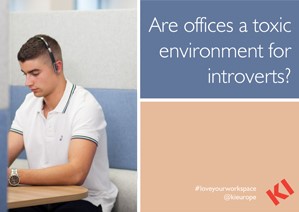 Are offices a toxic environment for introverts?
Are offices a toxic environment for introverts?
One of the findings of our survey was that in general, extraverts reported significantly higher levels of job satisfaction and happiness at work than introverts did. One practical question is therefore; is there anything about the design of the workplace that disadvantages introverts, and if so how can this be ameliorated?
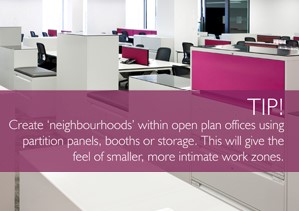 Large, high-density open plan layouts
Large, high-density open plan layouts
The proliferation of open-plan working may have been driven in part by a perception that open-plan offices can facilitate communication and diminish the negative effects of rigid hierarchies in organisations. However, research suggests that any such benefits are outweighed by the negative effects of the open plan environment (Kim & de Dear, 2013), such as noise levels, distraction, and lack of privacy.
Indeed, in our survey, those working in an open-plan office were among the least satisfied with their work environment.
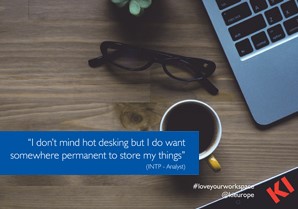 Hot desking
Hot desking
Where some types didn’t mind it, or may actually enjoy the variety, movement, and interaction that hot desking facilitates, on the whole, it was counter-intuitive to most people’s preference for having their own, defined space at work.
In our survey, hot-desking was distinctly unpopular with 79% of the group agreeing or strongly agreeing with the statement “It is important that I have my own desk and working area”.
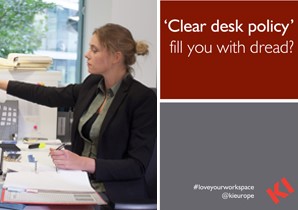 Clear desk policies
Clear desk policies
Particularly relevant (but not exclusive to) hot desking environments, clear desk policies improve tidiness, but virtually eliminate possibilities of personalising workspaces.
The research found that for reasons ranging from an expression of self identity, to a reminder of a caring gesture, or an effort to create a more homely environment - many individuals express a strong desire to add personal items to their immediate surroundings. A clear desk policy can therefore significantly reduce a feeling of engagement or connectedness to a workplace.
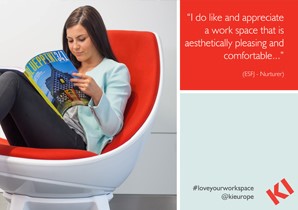 'Cool' offices
'Cool' offices
As the lines between domestic and corporate environments continue to blur, workplace environments are increasingly being used as a tool for employee engagement, wellbeing and employer branding.
While well-designed, aesthetically pleasing offices were almost universally appreciated amongst our sample, the presence of new gadgets, quirky objects, and statement décor was more highly valued by some.
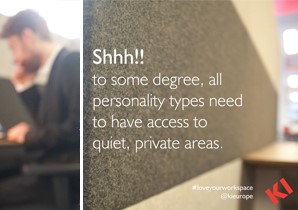 Quiet areas
Quiet areas
As the transition from a manufacturing to a service-based economy continues, the nature of our work has simultaneously become less process-driven and more interactive.
Subsequent increases in noise and movement can hamper the productivity of adjacent workers. Because collaboration can happen anywhere, at any time, it is difficult to dictate defined ‘collaboration zones’. Impromptu gatherings can start at a workstation and move on to more enclosed meeting rooms.
Our research showed that even those who you might expect to enjoy being around fellow loud, enthusiastic people need to get away from the action from time to time. Others are able to carry on without disruption, even in a noisier environment.